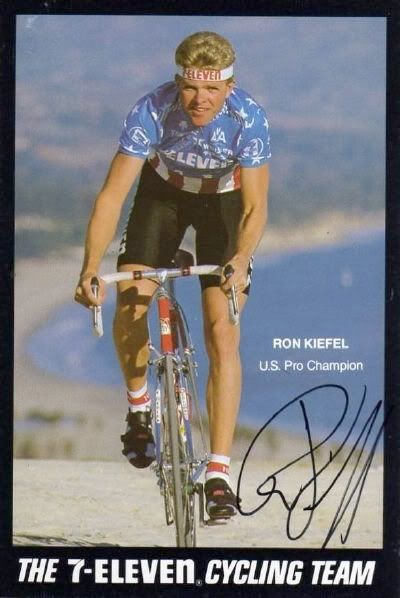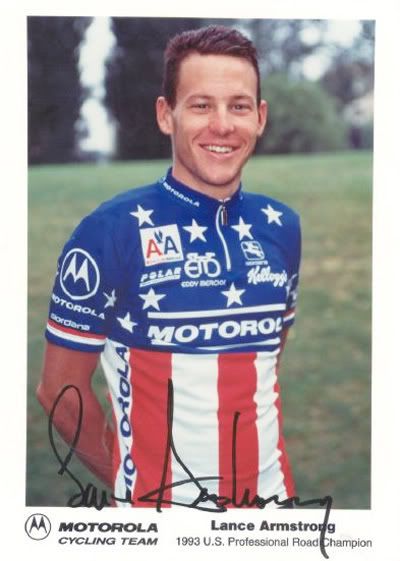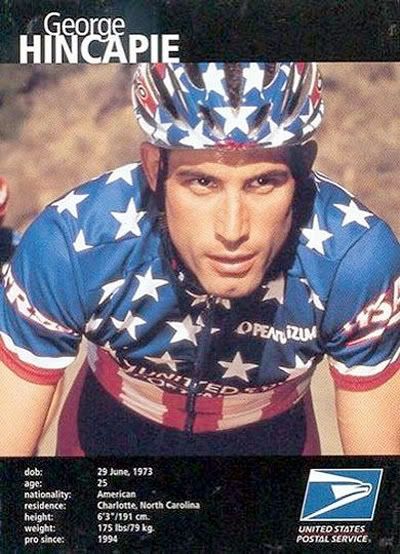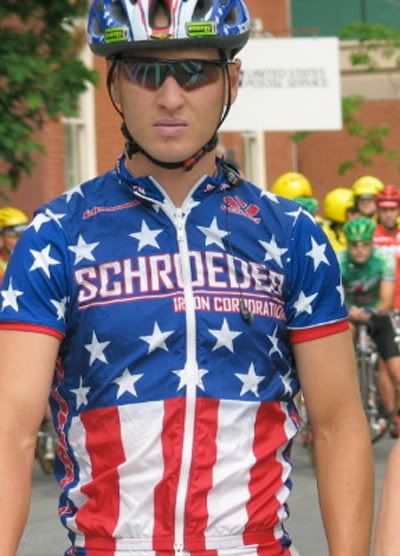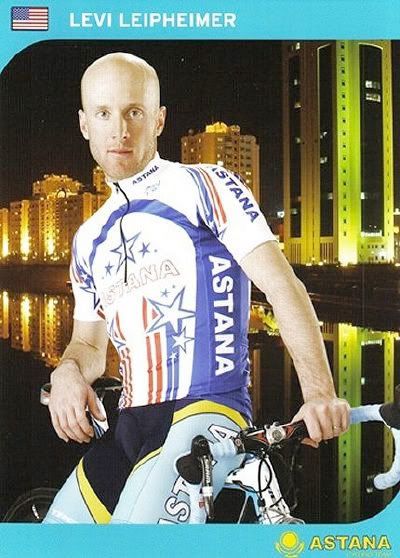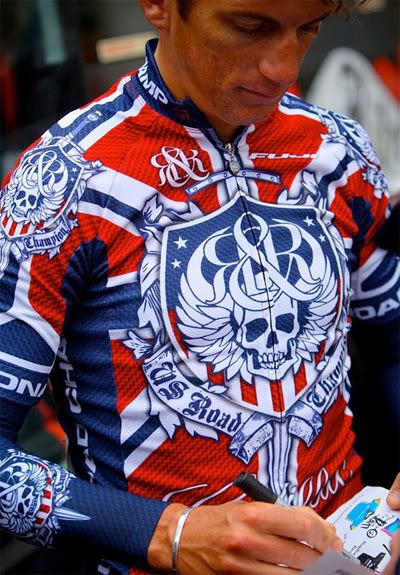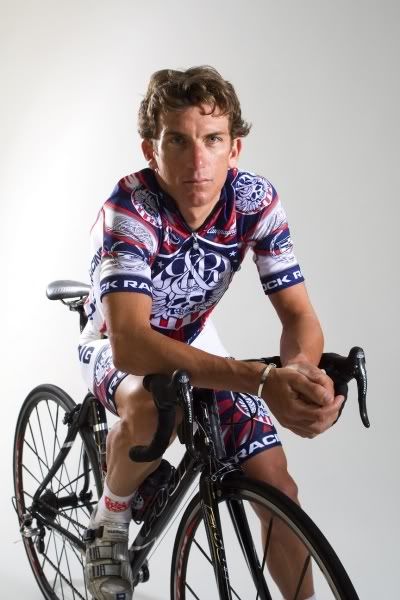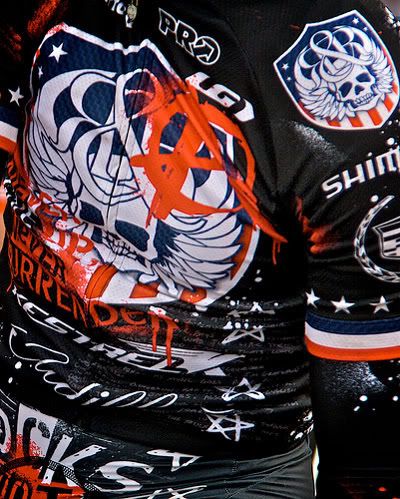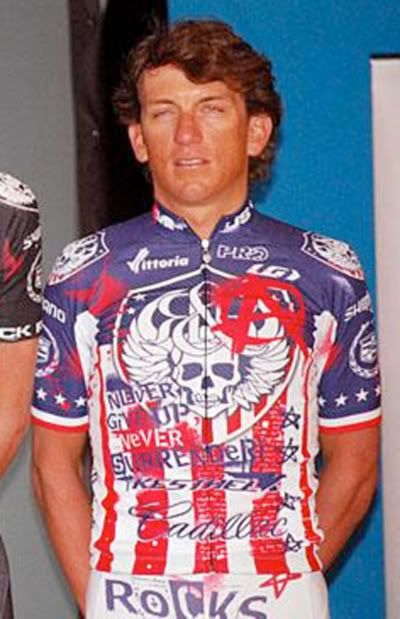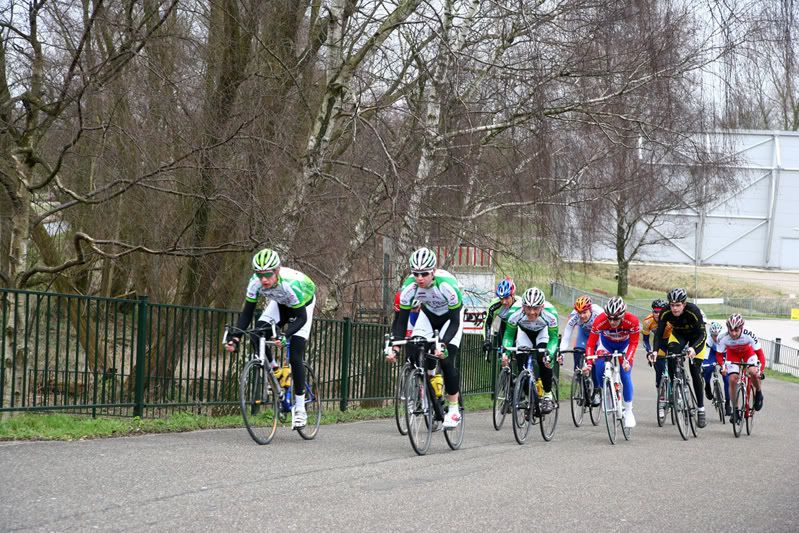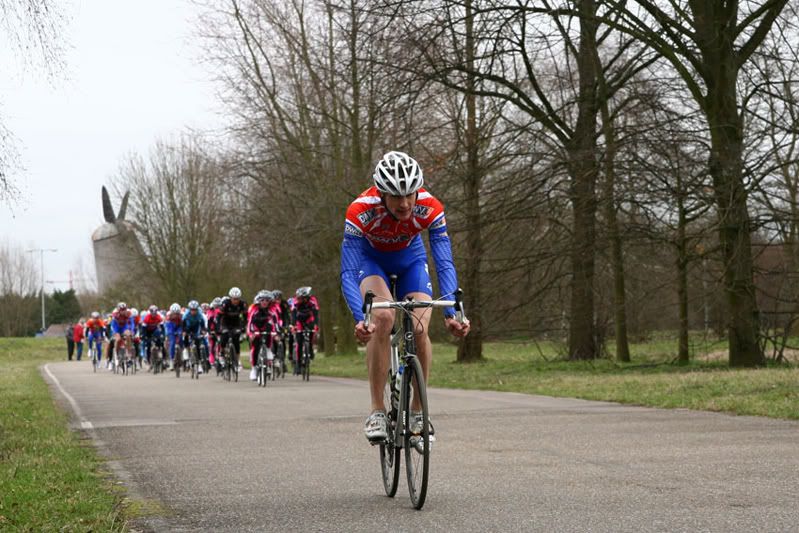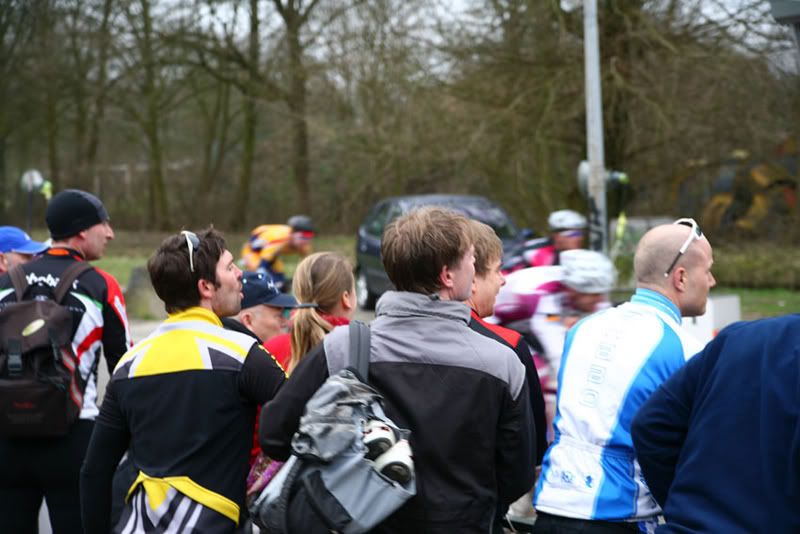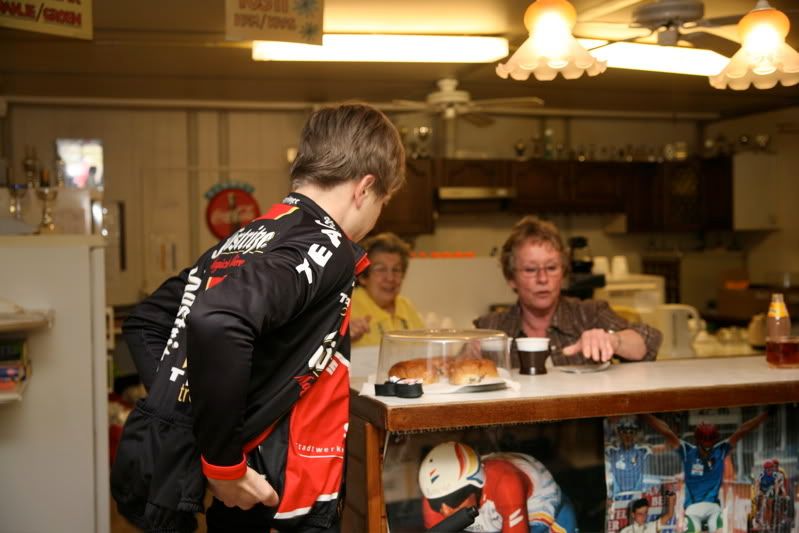I just saw a simple spot commercial on Belgian TV. At the most it was a vignette. A man, wearing an old school wool cycling jersey, sitting at a table. He breaks an egg, drops it into a glass of dark beer, and knocks it back. It ends with the question "Wij Zijn er Klaar Voor?", which translates as "who's up for it?"
There was no need to say what "it" is. If you live in Flanders, you know.
Yes, the countdown begins. A week from now, there will be a new winner of Vlaanderens mooiste. So, with that in mind, I present a commercial, with so many references to Stephan Vanfletteren's Flandrien, that I wouldn't be surprised if he directed it. Brought to you by Het Nieuwsblad.
Enjoy.
are sometimes smooth and silky, and other times tired and tight.
Sunday, March 29, 2009
Monday, March 23, 2009
Stars, Stripes, Blocks, Union Jacks, and Anarchy (a visual history)
Last month, while checking the photos from the Tour of California, I noticed the continuation of a bad trend. Namely the bastardization of the US Road Champions jersey, one of the most distinctive, and finer national champions jerseys out there.
Sure, the Belgian tricolor is pretty cool, as is the Italian, but apart from different hues of the same color the Dutch, and the Luxembourg champions jerseys are almost the same. If you're not paying attention, you might confuse both for being the the French jersey, except the French, being the contrarians that they are, flipped the red and blue. Then you've got a bunch of white jerseys with colored stripes on white, like the German, British, and Australian. Boring.
I'm all for innovation, and would hardly call myself someone who's overly nostalgic for the good old days. I just wonder why someone would tinker with a jersey as simple as the ol' Captain America stars and stripes?
Maybe the whole rethinking of the stars and stipes can be blamed on Banesto, who weren't happy that their star rider - Miguel Indurain - won the Spanish Championship, the week before the Tour de France. Wearing the tricolor would apparently have diminished the impact of the Banesto look (or maybe this was all smoke and mirrors to cover upo the fact that Indurain, the Basque, didn't want to wear Spanish colors?). Their solution? Instead of a trilcolor jersey, wide red and yellow bars were added to the sleeves.
OK, enough talk, let's just look at the jersey, and how its design has progressed over the years.
In 1988, Ron "The Wookie" Kiefel, debuted the stars and stipes at the Tour De France. Note the introduction of sponsors name and logos, otherwise, it's clean and simple.
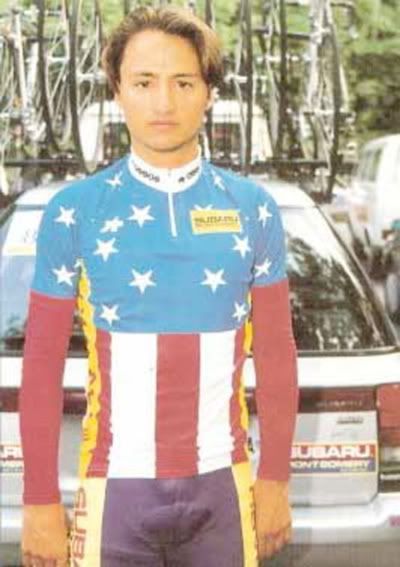
In 1992 Bart Bowen's jersey design includes yellow side panels to give the sponsor some added notice. To make up for that, they left the field of blue virtually untouched.
In 1993 a certain baby faced racer from Texas found himself in the stars and stripes. The yellow side panels were 86ed, but the sponsors logos came back, and in full effect, almost overwhelming the stars. For what it's worth, Big Tex made the most out of that jersey for the +/-8 weeks that he wore it before trading it in for a better one.
After several years absence, George Hincapie brought the stars and stripes back to to Tour de France in 1998. Other than adding a stars and stripes helmet, the ensemble retained it's classic look.
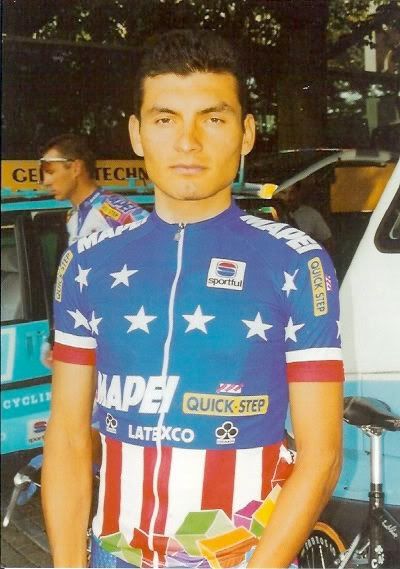
Fred Rodriguez won the first of his three US Pro Road Championships in 2000. Apparently the designers at Sportful didn't get the memo that "if it ain't broke, don't fix it." They decided to add some of those Mapie blocks to the bottom of the jersey. While one could say it was playful - it was - others might say it was unnecessary. I never liked the Mapie jerseys, so I think you might know where I stand.
Chann MacRae brought back the simple stars and stripes in 2002, and for that we were glad.
In 2003 the designer of Mark McCormack's kit got a little carried away with his/her stars. I suppose they were overcompensating for the enormous logo they slapped on the chest.
After a brief hiatus from top European racing, Fast Freddy brought the stars and stripes jersey back to the big show in 2004. This time the designers kept it simple.
In 2005 Chris Wherry sported the national champions jersey. This may have been the last year that the stars and stripes were - more or less - left intact. Then again, Wherry's team, Toyota United, wore kit that could have been confused for US Champion kit. Toyota weren't bad, but they weren't that good.
2006 is the year when things started to go drastically wrong when George Hincapie won his second national championships. Someone at Nike, or Trek, or whomever designed their kit, clearly was let off the leash. The result? Subliminal stars; red stripes on the shoulders; the LiveStrong inspired design flourish of the singular yellow band on the arm; and a big blue marble slapped on top. What a mess.
Now, just when you thought it couldn't get anyway worse than Big George's jersey, it does. What in god's name was the designer responsible for Levi Leipheimer's 2007 champions jersey thinking? Where's the stars, where's the stripes? All I see are some vertical stripes, with a few stylized stars. I can only imagine what little Levi thought when he first saw the kit.
Seeing as he races for a team that does everything their own way, it shouldn't have come as a surprise that Tyler Hamilton's US Champions jersey would continue the trend of being different than years past. Thing is, who would have ever expected that on his debut as the US Champion, Hamilton's stars and stripes would be replaced by the bars of a Union Jack at last years Tour of Britain? Not me.
Maybe Michael Ball realized the error of his ways, because the next appearance that Hamilton made wearing the jersey was in this photo shoot, for an October 2008 issue of VeloNews. If you look, you can see that there's some stars and stripes in there. Not tons, but hey, they tried.
At this years Tour of California, Hamilton's national champions status got all stealthy. Who would have ever imagined that designers at Rock and Republic were capable of subtlety? Not me. But that's precisely what they were.
If you look hard, you can see that Hamilton had some red and white stripes inside the Rock Racing logo. He's also sporting stars and stripes on his arms, which is strange, seeing as that's normally reserved for former champions.
Now, the last images I saw of Tyler Hamilton came from the Vuelta Mexico Telmex. Either Rock Racing were sent a stern letter from USA Cycling, or they like to redesign the national champions kit almost as much as they redesign their own. The latest incarnation of Hamilton's kit almost brings us back to the classic stars and stripes.
Sure, there's an Anarchy A in there, and some sublimated stencil aesthetics, but hey... it almsot looks a national champions jersey that even Eric Heiden might wear. Or not?
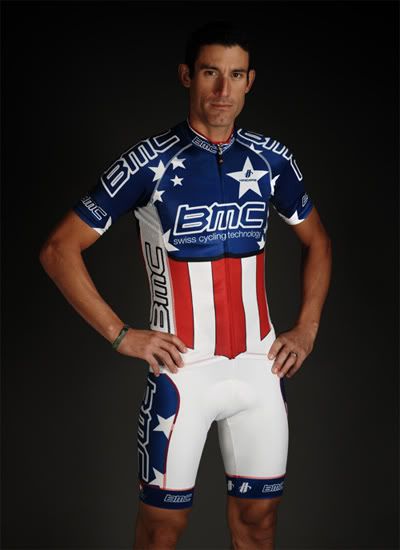
By the time that Big George made it a hattrick of championships, he must have known what he wanted, and what he didn't. I'm sure it also helped being an investor in the company that made his kit.
This time the kit has (more or less) gone back to basics. Stars. Stripes. White Shorts? Well, two out of three isn't bad.
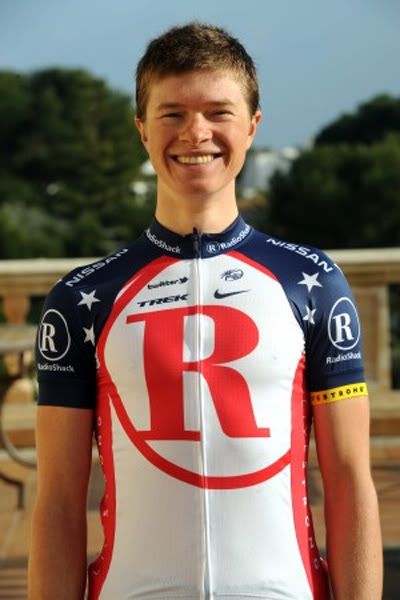
After the slow creep back to the classic look, it should come as no surprise that the people responsible for Big George's second jersey and Levi's mystery champion jersey would return with another stealth champions jersey.
Poor Ben King. Comes out of nowhere to become US Champion, and no one gets the chance to notice.

Fred Rodriguez won the first of his three US Pro Road Championships in 2000. Apparently the designers at Sportful didn't get the memo that "if it ain't broke, don't fix it." They decided to add some of those Mapie blocks to the bottom of the jersey. While one could say it was playful - it was - others might say it was unnecessary. I never liked the Mapie jerseys, so I think you might know where I stand.
Chann MacRae brought back the simple stars and stripes in 2002, and for that we were glad.
In 2003 the designer of Mark McCormack's kit got a little carried away with his/her stars. I suppose they were overcompensating for the enormous logo they slapped on the chest.
In 2005 Chris Wherry sported the national champions jersey. This may have been the last year that the stars and stripes were - more or less - left intact. Then again, Wherry's team, Toyota United, wore kit that could have been confused for US Champion kit. Toyota weren't bad, but they weren't that good.
2006 is the year when things started to go drastically wrong when George Hincapie won his second national championships. Someone at Nike, or Trek, or whomever designed their kit, clearly was let off the leash. The result? Subliminal stars; red stripes on the shoulders; the LiveStrong inspired design flourish of the singular yellow band on the arm; and a big blue marble slapped on top. What a mess.
Now, just when you thought it couldn't get anyway worse than Big George's jersey, it does. What in god's name was the designer responsible for Levi Leipheimer's 2007 champions jersey thinking? Where's the stars, where's the stripes? All I see are some vertical stripes, with a few stylized stars. I can only imagine what little Levi thought when he first saw the kit.
Seeing as he races for a team that does everything their own way, it shouldn't have come as a surprise that Tyler Hamilton's US Champions jersey would continue the trend of being different than years past. Thing is, who would have ever expected that on his debut as the US Champion, Hamilton's stars and stripes would be replaced by the bars of a Union Jack at last years Tour of Britain? Not me.
Maybe Michael Ball realized the error of his ways, because the next appearance that Hamilton made wearing the jersey was in this photo shoot, for an October 2008 issue of VeloNews. If you look, you can see that there's some stars and stripes in there. Not tons, but hey, they tried.
At this years Tour of California, Hamilton's national champions status got all stealthy. Who would have ever imagined that designers at Rock and Republic were capable of subtlety? Not me. But that's precisely what they were.
If you look hard, you can see that Hamilton had some red and white stripes inside the Rock Racing logo. He's also sporting stars and stripes on his arms, which is strange, seeing as that's normally reserved for former champions.
Now, the last images I saw of Tyler Hamilton came from the Vuelta Mexico Telmex. Either Rock Racing were sent a stern letter from USA Cycling, or they like to redesign the national champions kit almost as much as they redesign their own. The latest incarnation of Hamilton's kit almost brings us back to the classic stars and stripes.
Sure, there's an Anarchy A in there, and some sublimated stencil aesthetics, but hey... it almsot looks a national champions jersey that even Eric Heiden might wear. Or not?

By the time that Big George made it a hattrick of championships, he must have known what he wanted, and what he didn't. I'm sure it also helped being an investor in the company that made his kit.
This time the kit has (more or less) gone back to basics. Stars. Stripes. White Shorts? Well, two out of three isn't bad.

After the slow creep back to the classic look, it should come as no surprise that the people responsible for Big George's second jersey and Levi's mystery champion jersey would return with another stealth champions jersey.
Poor Ben King. Comes out of nowhere to become US Champion, and no one gets the chance to notice.
Tuesday, March 17, 2009
Lance say Relax
"It is obvious he still has a lot to learn,"
"He is the best rider in the world but the only negative point, and I respectfully say that, is that he is too nervous... He is too good to be so nervous."
"(Contador) can learn from me and from Johan"
"I know a lot of things about cycling...and the best thing to learn is how to relax. That is why we have decided to race together in the Tour of Castilla y Leon."
I don't know, when I read quotes from The Boss like these, I either think of this, or this -

Am I the only one?
Monday, March 16, 2009
Saturday, March 14, 2009
Race Report (Dutch Toothpaste)
If anyone has read Dan Coyle's book Lance Armstrong's War, then they might be familiar with the term "Belgian Toothpaste." The term refers to the grit, grime, and manure that gets sprayed on to the faces and bodies of cyclists in Belgium, during the wet and windy Belgian races of March and April.
If the google hits for the term are anything to go by, it might be one of the more enduring legacies of the book. There are countless people out there who apparently take pride in the fact that they've quite literally eaten shit in liquid form, while riding their bike.
Well, yours truly is not one of those said people.
If the google hits for the term are anything to go by, it might be one of the more enduring legacies of the book. There are countless people out there who apparently take pride in the fact that they've quite literally eaten shit in liquid form, while riding their bike.
Well, yours truly is not one of those said people.
Tuesday, March 10, 2009
Thunderbirds are go?
With Silence-Lotto switching bike supplier from Ridley to Canyon this season, Evans came to Paris-Nice with the intention to get used to the new equipment, especially with regards to his time trial bike.I wonder if he named his bike Thunderbird 5?
cyclingnews.com

Monday, March 9, 2009
Detours
I thought the body was the wierdest reason I'd ever have to take a detour. Maybe, maybe not. Years ago, during the inaugural NYC TA century, I found myself in the front group. While these kinds of rides are rides, and not races, at the time I didn’t know any better. We had been riding at a brisk pace, following the course markings, focused on getting to the finish in Union Square.
As weaved our way through van Cortland Park, in the Bronx, we came to a junction in the road that was blocked by yellow tape, with “police line do not cross” printed on it. Strange. A couple of riders promptly ducked under the tape, and continued riding. The rest of us followed suit, until we spotted a group of cops, about 30 meters ahead.
One of New York’s finest noticed that there was a group of 10-12 men in lycra riding through their crime scene, and told us in very direct language that we should find another way to Union Square. That’s when I noticed that the police were standing by a park bench, with a white sheet covering it. A white sheet, with a large red blotch seeping through it, I should add.
Now, call me unimaginative, but I never imagined I’d experience such a surreal detour again. Maybe, maybe not, which leads me to why I’m reminiscing about my own real life version of Law & Order.
Yesterday, I was out on the road with my old friend, the KM, riding a +/- 70 km loop, known as the Haarlemermeer. It’s nothing special, most of the time you ride along canals, the one thing that makes it slightly unique is that the route brings you past/around Schiphol.
As we rode a steady pace, I spotted a few faces from the race the day before. My legs were sore, but the company was good. It was a nice, albeit unremarkable ride. That was until we aproached two raod barriers, marked “No Pedestrians”, blocking the road ahead. I slowed, unsure of what to do. Meanwhile the KM continued on, riding between the barriers. Just as I was about to follow, I spotted a man jump out of a car. He was wearing a Neon yellow suit, with Verkeersregelaar printed on it. He shouted from the KM to stop, and the KM complied.
I soft pedal over to them, and listen as Neon man tells us that we can’t go down this route, while the KM points out that the sign said no pedestrians, not no bicycles. They banter for a bit. A few motorcycle cops come out of nowhere. The KM continues pointing out that the sign says nothing about bicycles, but there’s no way we’re going to be able to continue. I look up the road, and realize why. I can see, off in the distance, just off of the road, in a field, the ten day old wreckage of a Boeing 737.

photo source
As weaved our way through van Cortland Park, in the Bronx, we came to a junction in the road that was blocked by yellow tape, with “police line do not cross” printed on it. Strange. A couple of riders promptly ducked under the tape, and continued riding. The rest of us followed suit, until we spotted a group of cops, about 30 meters ahead.
One of New York’s finest noticed that there was a group of 10-12 men in lycra riding through their crime scene, and told us in very direct language that we should find another way to Union Square. That’s when I noticed that the police were standing by a park bench, with a white sheet covering it. A white sheet, with a large red blotch seeping through it, I should add.
Now, call me unimaginative, but I never imagined I’d experience such a surreal detour again. Maybe, maybe not, which leads me to why I’m reminiscing about my own real life version of Law & Order.
Yesterday, I was out on the road with my old friend, the KM, riding a +/- 70 km loop, known as the Haarlemermeer. It’s nothing special, most of the time you ride along canals, the one thing that makes it slightly unique is that the route brings you past/around Schiphol.
As we rode a steady pace, I spotted a few faces from the race the day before. My legs were sore, but the company was good. It was a nice, albeit unremarkable ride. That was until we aproached two raod barriers, marked “No Pedestrians”, blocking the road ahead. I slowed, unsure of what to do. Meanwhile the KM continued on, riding between the barriers. Just as I was about to follow, I spotted a man jump out of a car. He was wearing a Neon yellow suit, with Verkeersregelaar printed on it. He shouted from the KM to stop, and the KM complied.
I soft pedal over to them, and listen as Neon man tells us that we can’t go down this route, while the KM points out that the sign said no pedestrians, not no bicycles. They banter for a bit. A few motorcycle cops come out of nowhere. The KM continues pointing out that the sign says nothing about bicycles, but there’s no way we’re going to be able to continue. I look up the road, and realize why. I can see, off in the distance, just off of the road, in a field, the ten day old wreckage of a Boeing 737.

photo source
Monday, March 2, 2009
Race Report (Sandbagging, bad timing, what to do?)
Race day.
Last day. February.
Bad timing. What to do?
Race and not watch, or Sandbag and watch? That was the question.
A smart man would not even think twice. He’d race. Yet your humble narrator, could not resist the temptation to watch the first big race of the year – the Omloop - on TV. So, a plan was devised. I hasten to add, not by me.
Four of us were to meet early; ride for an hour; turn up for the earlier, easier race, and hope that the organizers would understand our plight, and let us ride. Sounds simple enough, and surprisingly it was.
What to say about the race? Not much. I had no intention of racing it, per se. No. I was there to get some time on the saddle, and put in some efforts. One of my Gang of Four had other plans, and did his best to get away, which managed to, in a group of three. I moved myself up to the front of the group, and started soft pedaling.
Much to my surprise, everyone complied. Ten, fifteen, twenty minutes later – I’m not sure, I wasn’t paying attention – the group was pulled in. A few laps later, another friend, Mr. Late, pulls alongside, and tells me that he has a plan. We’re to rev things up with four laps to go, with the intention of launching our friend to a winning break. I thought it was a few laps too soon, but nodded in agreement. We may have been sandbagging, but we are human. The time comes, and the plan fails, much as I expected.
Bad timing. For once, Mr. Late is too early.
The bell lap arrives, and I move up, placing myself about 5th wheel, in front of the friend who’s racing for a result, and behind Mr. Late. We hit the last long straight, and Late opens it up.
I shout to him. Trying to tell him to not completely bury himself so we can work together, knowing that as long as we keep it fast, nobody will try and come around, and we can make one last effort to launch our friend. He pulls off, and it’s my turn. I keep the tempo, until I hear Late shouting. There’s a gap?
I see someone bridging up to me, and jump on his wheel. There are two of us, and we have a legitimate chance on fighting for the win. We take a few turns, and then I remind myself that I wasn’t here to race. We hit the last hurdle of the course, a viaduct, less than 500 meters to go.
Race day.
Last day. February.
What to do? I brake, and watch as the field sprints past in pursuit.
.
Last day. February.
Bad timing. What to do?
Race and not watch, or Sandbag and watch? That was the question.
A smart man would not even think twice. He’d race. Yet your humble narrator, could not resist the temptation to watch the first big race of the year – the Omloop - on TV. So, a plan was devised. I hasten to add, not by me.
Four of us were to meet early; ride for an hour; turn up for the earlier, easier race, and hope that the organizers would understand our plight, and let us ride. Sounds simple enough, and surprisingly it was.
What to say about the race? Not much. I had no intention of racing it, per se. No. I was there to get some time on the saddle, and put in some efforts. One of my Gang of Four had other plans, and did his best to get away, which managed to, in a group of three. I moved myself up to the front of the group, and started soft pedaling.
Much to my surprise, everyone complied. Ten, fifteen, twenty minutes later – I’m not sure, I wasn’t paying attention – the group was pulled in. A few laps later, another friend, Mr. Late, pulls alongside, and tells me that he has a plan. We’re to rev things up with four laps to go, with the intention of launching our friend to a winning break. I thought it was a few laps too soon, but nodded in agreement. We may have been sandbagging, but we are human. The time comes, and the plan fails, much as I expected.
Bad timing. For once, Mr. Late is too early.
The bell lap arrives, and I move up, placing myself about 5th wheel, in front of the friend who’s racing for a result, and behind Mr. Late. We hit the last long straight, and Late opens it up.
I shout to him. Trying to tell him to not completely bury himself so we can work together, knowing that as long as we keep it fast, nobody will try and come around, and we can make one last effort to launch our friend. He pulls off, and it’s my turn. I keep the tempo, until I hear Late shouting. There’s a gap?
I see someone bridging up to me, and jump on his wheel. There are two of us, and we have a legitimate chance on fighting for the win. We take a few turns, and then I remind myself that I wasn’t here to race. We hit the last hurdle of the course, a viaduct, less than 500 meters to go.
Race day.
Last day. February.
What to do? I brake, and watch as the field sprints past in pursuit.
.
Subscribe to:
Posts (Atom)

